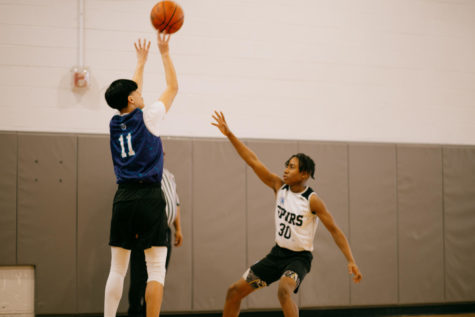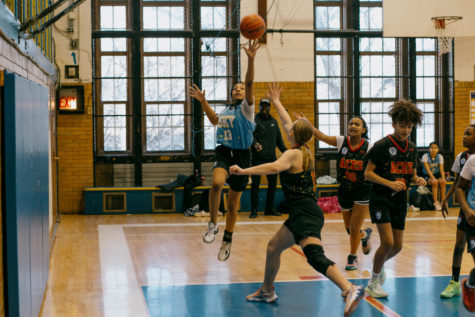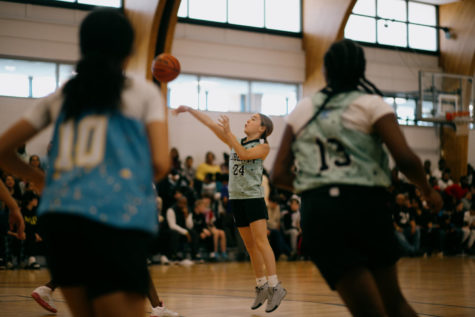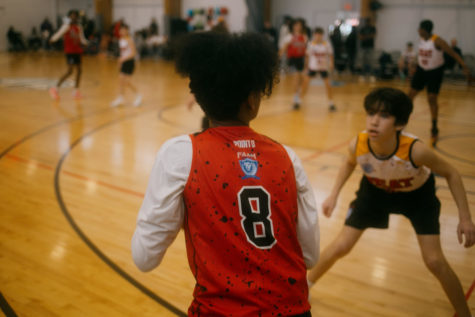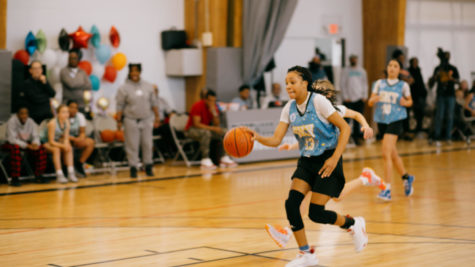Your donation will support the student journalists of the Evanstonian. We are planning a big trip to the Journalism Educators Association conference in Philadelphia in November 2023, and any support will go towards making that trip a reality. Contributions will appear as a charge from SNOSite. Donations are NOT tax-deductible.
‘More than just a basketball league’
Founded in 1968, local Evanston organization is a slam dunk for building community.
April 20, 2023
Saturday mornings at Fleetwood-Jourdain Community Center are nothing short of electric. This facility serves as the Fifth Ward’s local recreation center and holds the title as the oldest standing community center in Evanston. Since its inception in 1968, the Fellowship of African American Men Youth Basketball League, better known as FAAM, has depended on Fleetwood to accommodate its student athletes. Located in the heart of the city, the community center is a hub of activity throughout the entirety of the year. During FAAM’s season, young and old people alike set foot in the gymnasium to support, sustain and suit up.
Spectators enter the gymnasium while sipping a warm cup of coffee–in an attempt to combat morning fatigue and stave off the winter chill–and leave Fleetwood with a bucket of popcorn in one hand and a soft pretzel in the other. The sound of squeaking sneakers on the polished hardwood floors echoes throughout the space as the players prepare to face their opponent. An assortment of basketballs are distributed and the players form an impromptu layup-line; as each ball hits the stiff surface of the gym, it gives rise to a subsequent thud and a cadence that is unique to the sport. There is hardly any empty wall space; the gymnasium is adorned with banners celebrating the accomplishments of its many teams.
In most leagues, the term home-court advantage describes the benefit that the home team is said to have over the visiting team. However, the phrase loses its relevance at FAAM–every student athlete has the privilege of being at the receiving end of the animated remarks of the crowd. For spectators, coaches and players alike, the energy of FAAM is incomparable to any other house league on the North Shore.
Nearly fifty-five years ago, in 1968, Evanston School District 65 was forced to impose a restriction on school athletic programs due to financial constraints. These program cuts put a void in athletic activities for Evanston’s middle school students. Recognizing the immediate impact of such depletion, several African American men in Evanston were driven to restore what was lost through the establishment of FAAM.
Observing the organization’s potential, the founders designated four major objectives: to teach African American youth the value of good sportsmanship, to demonstrate the fundamentals of basketball, to communicate that athletics, though important in life, is secondary to education and to present positive and progressive African American men as role models for the student athletes.
The league commenced with four teams–all boys–but within just two decades, FAAM extended its limits to welcome female athletes and white students from not exclusively Evanston, but its neighboring suburbs as well. This past year, FAAM had 14 boys teams, 3 girls teams and a cheerleading squad. While the organization itself has appropriated both continuity and change, its values have remained virtually unchanged.
In April 2022, the league appointed their new president, Omar Brown. A well-versed figure in the Evanston community, Brown became involved with FAAM 17 years ago as an assistant coach with the Celtics. Initially, however, he was hesitant.
“When I first got asked to coach by [a volunteer], I was a young father. At the time, [I] couldn’t understand why I would want to spend my free time with someone else’s kid,” Brown said. “In response to my doubts, the coach said, ‘Hey, at least come to one practice and meet the players.’”
Brown claims that the spark was instant. His inclination to coach surrounds his investment in the Evanston community. Brown has served on the boards of several local organizations including Youth & Opportunity United (Y.O.U.), McGaw YMCA, Canal Shores, District 65 and the NorthShore University HealthSystem. Securing a leadership role within FAAM has instilled a new sense of agency in Brown; he hopes to build on the positive momentum and capitalize on the post-pandemic energy.
A microcosm of the local community, FAAM highlights the socioeconomic and ethnic diversity of its inhabitants.
“I would argue that [FAAM] is one of the few places in Evanston that brings every identity together. You have student athletes from Howard Street to Central Street, all coming together to play basketball coached primarily by Black people, which is unique in itself,” Brown said.
To that effect, FAAM attracts student athletes with a wide range of abilities and attributes. By modifying the environment and adjusting the style of play, the league’s coaches have become acquainted with meeting the diverse needs of their players.
“There [are] kids that play FAAM basketball that will go on to play high school basketball, [maybe even] college basketball and beyond. But on that same team, there are kids that will never play basketball again in their life,” Brown said. “When you think about the variance in skill level, there is [truly] no other program where athletes receive the same coaching and the same jersey.”
FAAM’s coaching staff demands that their student athletes expend every effort and “leave it all on the court.” The players expect the same energy in return.
“FAAM is more than just a basketball league. For young people, it is a rite of passage. The coaches spend their time feeding kids, giving rides home, buying shoes and ultimately, they serve as a mother or father figure,” said Alando “Spud” Massie, a devoted member of FAAM.
Coaching and mentoring are not mutually exclusive; FAAM fosters a culture in which the two roles function in tandem with one another to maximize growth and productivity.
“Through my [involvement] with FAAM, I’ve seen parents take kids in, which is such a valuable part of the organization. FAAM not only connects young individuals with friends, but families as well. For some kids that may not have [a] support system at home, it is key,” said former FAAM coach and longtime Evanston resident Brian Murphy.
FAAM is unique in the sense that it is entirely volunteer-run. The act of volunteering provides the volunteer with a level of satisfaction that causes the league to inadvertently promote intrinsic motivation. From barbers to professors to police officers, FAAM’s coaches view their involvement as a long-term commitment.
“FAAM is successful because of the unselfish volunteer coaches,” Massie said. “When I was a freshman at Xavier University in New Orleans, La., I ran into some issues. Rather than calling a family member, the first person I called was my FAAM coach, Rick Marsh. To this day, he’s somebody I lean on for advice in my personal life, my educational life and my work life. I want to be that tool for a lot of kids. My philosophy as a coach is to [ensure] that we’re not just talking about dribbling the basketball but also talking about things that relate to life.”
A coach for nearly 15 years, Massie is dedicated to the process. He views coaching as a way to give back to the community by offering the guidance and support that he received.
“While I never had the passion to coach before I started, I quickly fell in love with it and was very successful at it,” Massie said. “In the past thirteen years, my team has won seven championships. We have been as successful as they get winning-record wise, but with that being said, it’s more than just the wins and losses. It’s about impacting the lives of young people. I want to be someone that my players know they can lean on.”
The current landscape of community-based leagues is being interfered with as sports specialization and engagement in travel leagues becomes increasingly more common for young athletes. However, according to players that have experienced both, local programs offer a sense of affinity that alternative leagues are often incapable of executing.
“FAAM always had a unique feel compared to other [basketball programs], because it felt like I was playing for something more,” junior Yan Nalls said. “Recognizing that basketball is bigger than just the game, FAAM [introduced] the idea of brotherhood and sisterhood and to always be there for one another.”
FAAM is an indisputable example of the power of mixed-age play. Student athletes have the privilege of being on one team for three years, where growth is tangible. This process allows for cohesion, familiarity and a sense of belonging.
“When I was in sixth grade, I was playing against seventh and eighth graders like Lance Jones, Jaheim Holden and Ryan Bost. All these people would become my future teammates, but at the time, they provided me with really good competition,” said Blake Peters, who was a four-year varsity starter for the Kits before continuing his academic and athletic career at Princeton University. “When I played FAAM, I was never the best player; I was always playing against people that were better than me. That’s something I needed, because I couldn’t really find that anywhere else.”
Furthermore, FAAM enables coaches to see the profound change in their players. By providing a solid athletic foundation, the league’s coaches gain a level of satisfaction knowing that they are contributing directly to youth development, both on and off the court.
“For me, one of the best experiences is meeting a kid for the first time as a sixth grader when they [may be] small and shy [and] by the end of the three years, when they’re leaving as an eighth grader, they’re young men,” Brown said. “Being able to see them grow and become confident is a really special feeling.”
An effective youth program, one which meets the needs of its student athletes, provides the tools to facilitate a smooth transition for those who hope to play at the next level. For Peters, FAAM–a small beginning–served as the stepping stone to great success. From Fleetwood-Jourdain to Jadwin Gymnasium–Princeton University’s basketball arena–Peters credits much of his early development to the middle school league.
“When I [began] playing FAAM in sixth grade, I was just out of elementary school so being in a high pressure situation was a relatively stressful process [at first], but [I] got used to playing in front of people,” Peters said. “I developed a level of focus in FAAM that was really important once [I] got into high school. I learned how to concentrate on the game and not who was at the game.”
Through FAAM, senior Jonah Ross became familiar with the terminology and the pace of the game.
“In sixth and seventh grade, playing against people that [were] older than me, bigger than me and stronger than me got me physically and mentally ready for the next level of basketball,” Ross said.
A teammate of Ross’, Nalls reflected similar sentiments.
“FAAM [taught me] the importance of playing with toughness until the game ends. That mentality was instilled in [me] during [FAAM] and has carried [with me] into high school basketball,” Nalls said.
Nearly every member of Evanston’s basketball coaching staff played FAAM. The league has established a legacy that is passed from generation to generation.
“There is an indescribable connection [that] FAAM creates,” Murphy said. “I can walk into Beardsley Gym on a Friday or Saturday night for a game and see the FAAM coaches that coached when I played, FAAM and high school teammates of mine and the kids that I coached. On a [given] night, there are three generations of people that had something to do with FAAM in Beardsley Gym.”
When the league first commenced, FAAM’s founders pledged to help youth develop important life skills that would promote success within and outside the confines of Fleetwood-Jourdain. Decades later, FAAM still provides an indubitable sense of comradery, bringing strangers together by means of rooting for or playing on the same team.
“Sports do a great job of uniting people,” Peters said. “I played FAAM for three years and never won a championship, but the [league] taught me to stay focused on the important things in life.”


